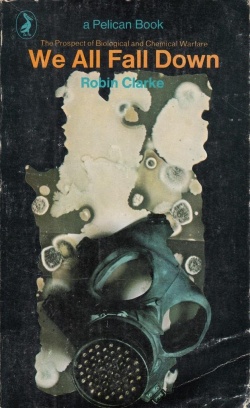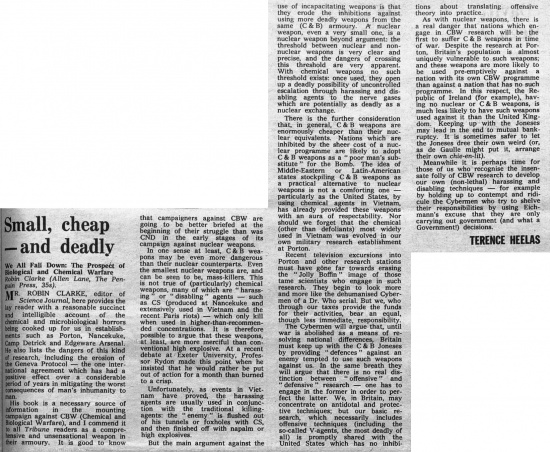Small, cheap — and deadly
- Publication: Tribune (London)
- Date: 1968-06-21
- Author: Terence Heelas
- Page: 9
- Language: English
We All Fall Down: The Prospect of Biological and Chemical Warfare Robin Clarke (Allen Lane, The Penguin Press, 35s).
MR. ROBIN CLARKE, editor of Science Journal, here provides the lay reader with a reasonable succinct and intelligible account of the chemical and microbiological horrors being cooked up for us in establishments such as Porton, Nancekuke, Camp Detrick and Edgeware Arsenal. He also lists the dangers of this kind of research, including the erosion of the Geneva Protocol — the one international agreement which has had a positive effect over a considerable period of years in mitigating the worst consequences of man's inhumanity to man.
His book is a necessary source of information in the mounting campaign against CBW (Chemical and Biological Warfare), and I commend it to all Tribune readers as a comprehensive and unsensational weapon in their armoury. It is good to know that campaigners against CBW are going to be better briefed at the beginning of their struggle than was CND in the early stages of its campaign against nuclear weapons. In one sense at least, C & B weapons may be even more dangerous than their nuclear counterparts. Even the smallest nuclear weapons are, and can be seen to he, mass-killers. This is not true of (particularly) chemical weapons, many of which are " harassing " or " disabling " agents — such as CS (produced at Nancekuke and extensively used in Vietnam and the recent Paris riots) — which only kill when used in higher-than-recommended concentrations. It is therefore possible to argue that these weapons, at least, are more merciful than conventional high explosive. At a recent debate at. Exeter University, Professor Rydon made this point when he insisted that he would rather be put out of action for a month than burned to a crisp.
Unfortunately, as events in Vietnam have proved, the harassing agents are usually used in conjunction with the traditional killing-agents: the " enemy " is flushed out of his tunnels or foxholes with CS, and then finished off with napalm or high explosives.
But the main argument against the use of incapacitating weapons is that they erode the inhibitions against using more deadly weapons from the same (C & B) armoury. A nuclear weapon, even a very small one, is a nuclear weapon beyond argument: the threshold between nuclear and nonnuclear weapons is very clear and precise, and the dangers of crossing this threshold are very apparent. With chemical weapons no such threshold exists: once used, they open up a deadly possibility of uncontrolled escalation through harassing and disabling agents to the nerve gases which are potentially as deadly as a nuclear exchange.
There is the further consideration that, in general, C & B weapons are enormously cheaper than their nuclear equivalents. Nations which are inhibited by the sheer cost of a nuclear programme are likely to adopt C & B weapons as a " poor man's substitute" for the Bomb. The idea of Middle-Eastern or Latin-American states stockpiling C & B weapons as a practical alternative to nuclear weapons is not a comforting one —particularly as the United States, by using chemical agents in Vietnam, has already provided these weapons with an aura of respectability. Nor should we forget that the chemical (other than defoliants) most widely used in Vietnam was evolved in our own military research establishment at Porton.
Recent television excursions into Porton and other research stations must have gone far towards erasing the "Jolly Boffin" image of those tame scientists who engage in such research. They begin to look more and more like the dehumanised Cybermen of a Dr. Who serial. But we, who through our taxes provide the funds for their activities, bear an equal, though less immediate, responsibility. The Cybermen will argue that, until war is abolished as a means of resolving national differences, Britain must keep up with the C & B Joneses by providing "defences" against an enemy tempted to use such weapons against us. In the same breath they will argue that there is no real distinction between " offensive " and "defensive" research — one has to engage in the former in order to perfect the latter. We, in Britain, may concentrate on antidotal and protective techniques; but our basic research, which necessarily includes offensive techniques (including the so-called V-agents, the most deadly of all) is promptly shared with the United States which has no inhibitions about translating offensive theory into practice.
As with nuclear weapons, there is a real danger that nations which engage in CBW research will be the first to suffer C & B weapons in time of war. Despite the research at Porton, Britain's population is almost uniquely vulnerable to such weapons; and these weapons are more likely to be used pre-emptively against a nation with its own CBW programme than against a nation that has no such programme. In this respect, the Republic of Ireland (for example), having no nuclear or C & B weapons, is much less likely to have such weapons used against it than the United Kingdom. Keeping up with the Joneses may lead in the end to mutual bankruptcy. It is sometimes safer to let the Joneses dree their own weird (or, as de Gaulle might put it, arrange their own chie-en-lit).
Meanwhile it is perhaps time for those of us who recognise the insensate folly of CBW research to develop our own (non-lethal) harassing and disabling techniques — for example by holding up to contempt and ridicule the Cybermen who try to shelve their responsibilities by using Eichmann's excuse that they are only carrying out government (and what a Government!) decisions.
Disclaimer: These citations are created on-the-fly using primitive parsing techniques. You should double-check all citations. Send feedback to whovian@cuttingsarchive.org
- APA 6th ed.: Heelas, Terence (1968-06-21). Small, cheap — and deadly. Tribune (London) p. 9.
- MLA 7th ed.: Heelas, Terence. "Small, cheap — and deadly." Tribune (London) [add city] 1968-06-21, 9. Print.
- Chicago 15th ed.: Heelas, Terence. "Small, cheap — and deadly." Tribune (London), edition, sec., 1968-06-21
- Turabian: Heelas, Terence. "Small, cheap — and deadly." Tribune (London), 1968-06-21, section, 9 edition.
- Wikipedia (this article): <ref>{{cite news| title=Small, cheap — and deadly | url=http://cuttingsarchive.org/index.php/Small,_cheap_%E2%80%94_and_deadly | work=Tribune (London) | pages=9 | date=1968-06-21 | via=Doctor Who Cuttings Archive | accessdate=15 December 2025 }}</ref>
- Wikipedia (this page): <ref>{{cite web | title=Small, cheap — and deadly | url=http://cuttingsarchive.org/index.php/Small,_cheap_%E2%80%94_and_deadly | work=Doctor Who Cuttings Archive | accessdate=15 December 2025}}</ref>

